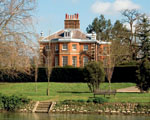Hampton Court Palace Pavilion
Penny Churchill looks at The Pavilion at Hampton Court Palace, and Glebe House at Aldenham: two houses for sale with impeccable architectural history.


Some of England's rarest, and most beautiful, country houses were built in the first decade of the 18th century, a period which, in architectural terms, saw the last of William and Mary and the best of Queen Anne. Two houses launched in Country Life this week The Pavilion at Hampton Court Palace, Richmond, Surrey, and Glebe House at Aldenham, Hertfordshire encapsulate the period at its most intriguing. The Pavilion at Hampton Court, the traditional summer residence of the royals, is the only surviving example of four garden pavilions built by Sir Christopher Wren for William III between 1700 and 1702. Wren used materials reclaimed from Queen Mary's house, the Old Water Gallery, which William had demolished in 1700. The pavilions were tucked away at the narrow end of a large oval enclosure containing the bowling green, and were intended for use as small private banqueting houses by the king's favourite courtiers, à la Versailles, but which, in fact, mainly served as gaming rooms or discreet meeting places. William never saw the completed buildings, as he died in 1702, and Anne probably never saw them either, as she spent only a few nights of her reign at Hampton Court Palace. But they were regularly used by others, and Ernest Law, the Hampton Court historian, suggests that they were the setting for Alexander Pope's Rape of the Lock in 1712. In the mid-1700s, the pavilions were occupied by Princess Amelia, the second daughter of George II, and refurbished in 1764 for the Duke of Gloucester, who lived there, on and off, until his death in 1805. The next tenant was Queen Victoria's father, Edward Duke of Kent, said to have been the most hated man in the British army, and who provoked a mutiny in Gibraltar during his time there as governor, his last official appointment. On his death in 1820, the pavilions by now in a state of some disrepair were taken on by his equerry, Gen James Moore, and later the general's widow, who saw them deteriorate even further, until three of them were demolished on Victoria's orders. In 1855, the last pavilion was restored and a new tenant appointed. In 1895, historian Ernest Law took over the tenancy and was allowed to extend the Pavilion by building a library and bedrooms over the kitchen, and enclose part of the riverside walk and the Home Park for his own use. Shortly after Law's death in 1930, his widow moved out, and the Pavilion was let to a succession of tenants until the Crown Estates Commission took it over in 1964. During their 10-year tenure, the present owners have made huge improvements to the property, installing a modern kitchen and bathrooms and renovating the historic interior, comprising four reception rooms, a study, a kitchen/breakfast room, four bedrooms, three bathrooms and a staff flat. The Pavilion, listed Grade II*, stands in 2.2 acres of walled gardens and grounds, with direct private access to the hundreds of acres of parkland surrounding this most royal of palaces. Knight Frank (020?7629 8171) quote a guide price of £6.5 million for the remaining Crown Estate 143-year lease. The same agents quote a guide price of £5.5m for the exquisite Glebe House at Aldenham, near Radlett, a Queen Anne gem of a house with its own intriguing history. There has been a manse on the site of the present house since the eighth century, and during the Civil War the vicarage was a focus of Royalist support in a strongly Parliamentarian region, as a result of which the vicar was removed from office for nine years. But the Restoration brought the return to influence of the Church of England, and the replacement, by 1707, of the rambling vicarage by a grander seven-bedroom house. The 3rd Lord Rendlesham, vicar from 1825 until 1833, extended the house northwards and built the cantilevered staircase. Other 19th-century incumbents contributed the north kitchen and the bay windows; the north dining room and garages were added in the 1970s. The present owners have painstakingly restored and upgraded the former rectory to its present trophy status. With five reception rooms, three bedroom suites, four further bedrooms, three further bathrooms, a tennis court, a swimming pool and 3.5 acres of immaculate gardens and grounds, Glebe House, listed Grade II, offers 21st-century living at its most quintessentially English.
Exquisite houses, the beauty of Nature, and how to get the most from your life, straight to your inbox.
Country Life is unlike any other magazine: the only glossy weekly on the newsstand and the only magazine that has been guest-edited by His Majesty The King not once, but twice. It is a celebration of modern rural life and all its diverse joys and pleasures — that was first published in Queen Victoria's Diamond Jubilee year. Our eclectic mixture of witty and informative content — from the most up-to-date property news and commentary and a coveted glimpse inside some of the UK's best houses and gardens, to gardening, the arts and interior design, written by experts in their field — still cannot be found in print or online, anywhere else.
-
 Sweet civilisation: What do you get when you ask architects to compete in a gingerbread competition?
Sweet civilisation: What do you get when you ask architects to compete in a gingerbread competition?The Gingerbread City is back in London’s Kings Cross. Lotte Brundle pays it a visit.
By Lotte Brundle Published
-
 Sophia Money-Coutts: A snob's guide to meeting your in-laws for the first time
Sophia Money-Coutts: A snob's guide to meeting your in-laws for the first timeThere's little more daunting than meeting your (future) in-laws for the first time. Here's how to make the right kind of impression.
By Sophia Money-Coutts Published

